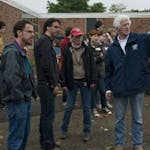LBJ
⋆⋆ out of four stars
Rated: R for profanity.
Director Rob Reiner's "LBJ," starring Woody Harrelson facially encased in latex and makeup best categorized as a good try, is a passably engaging biopic focusing on a few short and hugely eventful years in the life of our 36th president. But we wouldn't be paying so much attention to Harrelson's prostheses and makeup if the drama carried more urgency.
Decked out in the requisite lobe job, hairline and horn rims, Harrelson valiantly creates a performance halfway between impersonation and suggestion. He's often touching, and he clearly enjoys the ribald side of Johnson. But he never fully relaxes into an easy-breathing performance; he's locked inside a second-rate makeup job, and all too aware of expectations involving the portrayal of an extremely famous figure.
More successfully, although confined to the edges of the screenplay, Jennifer Jason Leigh's Lady Bird Johnson suggests several sides of her character simultaneously: comforter, manipulator and dimensional human being. "You knew what you wanted," she tells her insecure husband at one point. "And you got it."
The plot returns to the JFK assassination at Dealey Plaza in Dallas, over and over, as a motif. The final product is a straightfoward, frustratingly mild portrait of a man who, in "Hamilton"-speak, wanted to be in the room where it happened, but who really just wanted to be loved and respected.
michael phillips, Chicago Tribune
Jane
⋆⋆⋆ out of four stars
Rated: PG.
Theater: Edina.
Brett Morgen's documentary "Jane" will delight those familiar with Jane Goodall and provide a vibrant introduction for newcomers. It tells Goodall's story largely through footage of her expeditions at a reserve in what is now Tanzania. She was 26 and had no scientific degree when she first ventured into the forest, hoping to gain acceptance from chimpanzees inclined to run from her.
As an opening title card explains, most of "Jane" comes from 16mm film shot by Hugo van Lawick, the renowned wildlife photographer who joined Goodall on her travels and eventually became her first husband. His footage has appeared before, notably in the 1965 National Geographic documentary "Miss Goodall and the Wild Chimpanzees," narrated by Orson Welles.
But Morgen's film also draws on more than 100 rediscovered hours from National Geographic's archives. The abundant raw material allows Morgen to construct the impression of a complete narrative arc and to show the tedious work of gaining the trust of the chimps and collecting data in fast-forward, conveying the excitement of scientific discovery with adventure-movie momentum.
The footage has been edited in a way that is not strictly faithful to chronology but complements the storytelling. Because the archival footage lacked sound, the natural noises — chimp grunts and bird chirps — have been created, seamlessly, from separate recordings made in the Gombe forest that Goodall once explored. Such editing-suite sleights of hand might displease purists, and so will an insistent score by Philip Glass, whose melodious montage glue has become something of a documentary cliché. But the flip side of such freehandedness is that "Jane," like Morgen's "Chicago 10" and "The Kid Stays in the Picture," is involving and immediate.
BEN KENIGSBERG, New York Times





